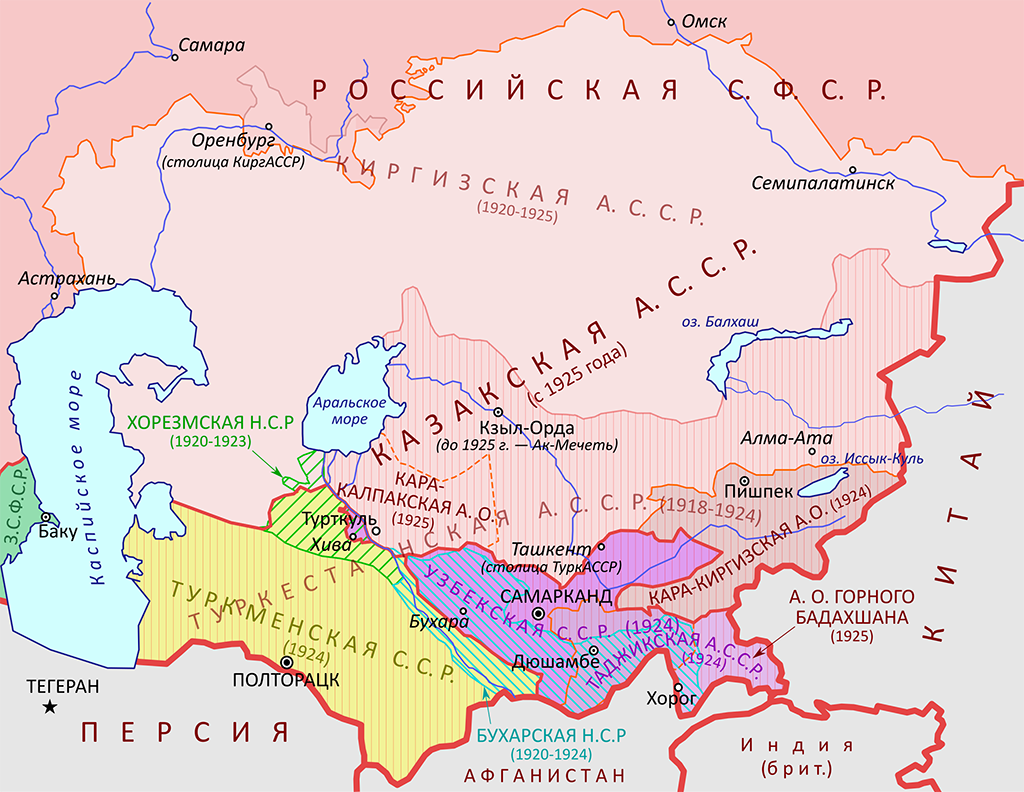

 Map of the national state delimitation of the republics of Central Asia (1924-1925). Light pink designates Central Asian republics as part of the RSFSR in 1924. By Hellerick, Wikimedia Commons, July 25, 2019. CC BY-SA 4.0
Map of the national state delimitation of the republics of Central Asia (1924-1925). Light pink designates Central Asian republics as part of the RSFSR in 1924. By Hellerick, Wikimedia Commons, July 25, 2019. CC BY-SA 4.0
We’re excited to continue our post series, where we share articles and video abstracts from the brilliant scholars featured in the recently released Fourth World Journal (FWJ), Volume 24, Issue 2.
In “Full Circle: Identity, Soviet Nationalities Policy, and Central Asia,” Joseph Fallon delves into the complexities of Central Asian tribal identity, bordering, and political power during the Soviet era. His article paints a salient portrait of the early Soviet era and the Russian conquest of Central Asia. Fallon’s in-depth regional knowledge is shown through his discussion of ethnic, linguistic, and clan-based identities among indigenous groups. He rightly portrays the indigenous peoples of the region with complexity and nuance—paying attention to the artificial imposition of borders that form the nations we see today.
Watch the author discuss their research and the insights behind this article in the video below.
Abstract
How did Soviet nationalism impact the diverse ethnic groups of Central Asia? This paper interrogates Soviet “modernization” policy toward different identity groups in modern Kazakhstan, Kyrgyzstan, Tajikistan, and Uzbekistan. Using an International Relations approach, the author problematizes the Leninist ethnoterritorial nationalist framework, arguing the complexities of ethnic identity in the region. As such, the creation of discrete bordered “socialist nations” is an artificial endeavor based on incorrect assumptions about the homogeneity of regional ethnic groups. The repeated divisions of Central Asia during the Bolshevik era attempted to catalyze the development of socialism within governable economic units of the Soviet empire. This phenomenon is clearly articulated in the Ferghana Valley region, which houses Uzbek, Tajik, and Kryrgz populations, among others. The geography of this area is analyzed to highlight the pitfalls of Soviet border delineation. Last, the article further explores the influence of the clan system during the nation-building period and the process of “korenizatsiia” or “indigenization,” which was used strategically by both clan leaders and soviet officials to harness political power.
About the author:

Joseph Fallon received his master’s degree in international affairs (MIA) from Columbia University, School of International and Public Affairs. Currently, he is a Senior Research Associate at the UK Defence Forum in London, England, UK, a contributor and International Advisory Board member of the journal Geopolitica, Bucharest, Romania, and a contributor to the Foreign Policy Research Centre in New Delhi, India.
Get full access to this article and the latest issue of the Fourth World Journal.
The library is dedicated to the memory of Secwepemc Chief George Manuel (1921-1989), to the nations of the Fourth World and to the elders and generations to come.
access here